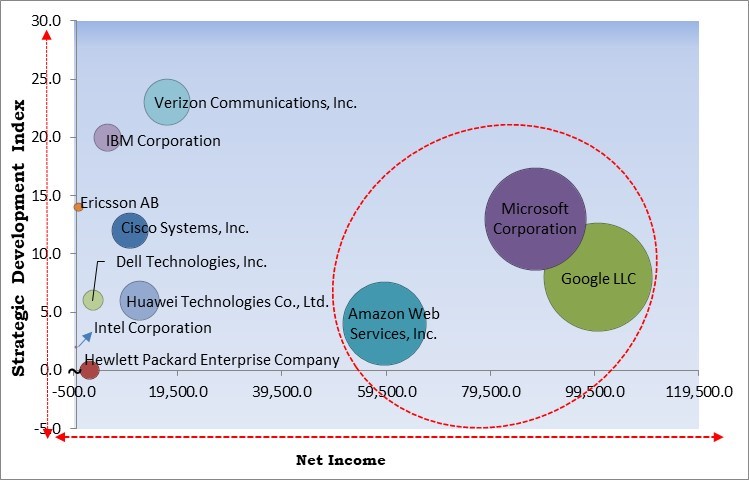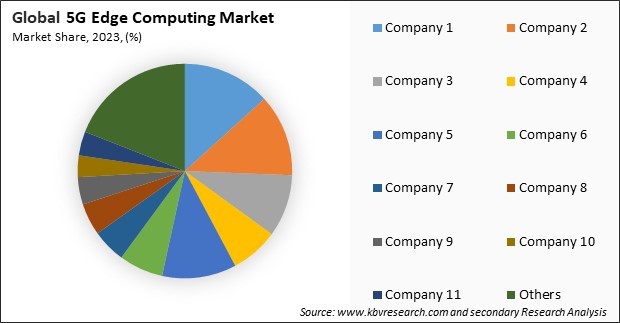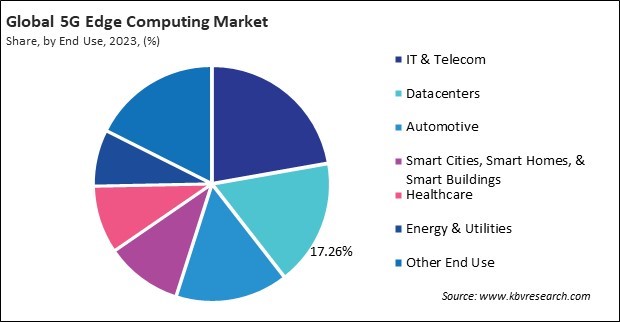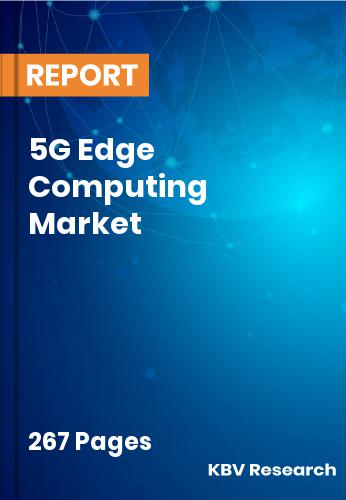“Global 5G Edge Computing Market to reach a market value of USD 69.02 Billion by 2031 growing at a CAGR of 46.9%”
The Global 5G Edge Computing Market size is expected to reach $69.02 billion by 2031, rising at a market growth of 46.9% CAGR during the forecast period.
The North America segment recorded 38% revenue share in the market in 2023. This dominance is driven by the rapid adoption of 5G technology, strong investments in edge computing infrastructure, and the presence of key market players in the region. The U.S. and Canada have been at the forefront of deploying advanced telecom networks, AI-driven applications, and cloud-native solutions, significantly contributing to market growth.

The major strategies followed by the market participants are partnerships as the key developmental strategy to keep pace with the changing demands of end users. For instance, In February, 2025, Ericsson AB announced the partnership with Telstra, a telecommunications company to launch a programmable 5G Advanced network, using Open RAN hardware and AI-driven automation to enhance network performance. The upgrade offers improved capacity, energy efficiency, and tailored connectivity services, supporting the growth of Industry 4.0 and empowering developers with new opportunities through network APIs. Additionally, In November, 2024, Cisco Systems, Inc. announced the partnership with NTT DATA, an IT company to provide global enterprises with secure, cost-effective 5G connectivity solutions. By leveraging Cisco’s eSIM technology and NTT DATA’s Transatel network, businesses can easily activate and manage mobile networks, transforming digital services for industries such as retail, finance, and manufacturing.
Based on the Analysis presented in the KBV Cardinal matrix; Google LLC, Microsoft Corporation, and Amazon Web Services, Inc. are the forerunners in this Market. In February, 2025, Google LLC announced the partnership with Amdocs, a telecommunications company to optimize 5G network operations using AI. Amdocs' new Network AIOps solution, powered by Google Cloud's AI infrastructure, automates network tasks, enhances performance, and reduces downtime. It utilizes predictive analytics, machine learning, and closed-loop automation to improve service reliability and customer experience. Companies such as Huawei Technologies Co., Ltd., Cisco Systems, Inc., and IBM Corporation are some of the key innovators in 5G Edge Computing Market.

The Internet of Things (IoT) rapidly transforms industries by enabling devices to communicate, analyze data, and automate processes. With billions of connected devices expected to be deployed in sectors such as healthcare, retail, transportation, and manufacturing, there is a growing need for real-time data processing. Traditional cloud computing models struggle to handle the massive influx of data generated by IoT devices, leading to network congestion and increased latency. In conclusion, the growing adoption of the Internet of Things (IoT) and connected devices is propelling the growth of the market.
Additionally, Latency-sensitive applications, such as autonomous vehicles, virtual reality (VR), augmented reality (AR), financial trading, and industrial automation, require effective real-time data processing. Even a few milliseconds of delay can significantly impact outcomes in these industries. For instance, autonomous vehicles must instantly process vast amounts of sensor data to detect obstacles, interpret traffic signals, and make split-second driving decisions. Any lag in data transmission could lead to accidents, making low-latency computing critical. Therefore, rising demand for ultra-low latency applications across multiple industries propels the market's growth.
However, implementing 5G edge computing requires significant financial investment, making it a major barrier to adoption. Unlike traditional cloud computing, which relies on centralized data centers, edge computing decentralizes data processing, requiring businesses to set up micro-data centers, edge servers, and high-speed fiber-optic networks closer to end users. Therefore, high initial investment and infrastructure deployment costs for 5G edge computing impede the market's growth.

The leading players in the market are competing with diverse innovative offerings to remain competitive in the market. The above illustration shows the percentage of revenue shared by some of the leading companies in the market. The leading players of the market are adopting various strategies in order to cater demand coming from the different industries. The key developmental strategies in the market are Partnerships & Collaborations.
Free Valuable Insights: Global 5G Edge Computing Market size to reach USD 69.02 Billion by 2031
On the basis of end-use, the market is classified into IT & telecom, smart cities, smart homes & smart buildings, data centers, energy & utilities, automotive, healthcare, and others. The data centers segment recorded 17% revenue share in the market in 2023. The rising demand for decentralized data processing and storage solutions has led to an increased focus on edge data centers. These facilities enable faster data transmission, reduce network congestion, and improve service efficiency.

Based on solution, the market is characterized by hardware, software, and services.The hardware segment procured 20% revenue share in the market in 2023. The demand for high-performance edge servers, routers, gateways, and processing units has increased due to the growing deployment of 5G networks worldwide. Enterprises and telecom providers are investing in specialized edge hardware to enable seamless data processing, reduce network congestion, and enhance the overall efficiency of edge computing infrastructure.

The 5G Edge Computing Market sees intensified competition among startups, telecom providers, and cloud service companies. Innovation accelerates as firms focus on cost-effective, low-latency solutions. Regional players and niche vendors gain traction, but the absence of industry leaders slows large-scale adoption, standardization, and investment, potentially hindering seamless ecosystem development and widespread enterprise deployment.
Region-wise, the market is analyzed across North America, Europe, Asia Pacific, and LAMEA. The Europe segment witnessed 31% revenue share in the market in 2023. The increasing focus on digital transformation, smart city initiatives, and industrial automation has fuelled the adoption of 5G edge computing across the region. Countries such as Germany, the UK, and France actively invest in edge infrastructure to support applications in autonomous vehicles, smart manufacturing, and IoT.
| Report Attribute | Details |
|---|---|
| Market size value in 2023 | USD 3.27 Billion |
| Market size forecast in 2031 | USD 69.02 Billion |
| Base Year | 2023 |
| Historical Period | 2020 to 2022 |
| Forecast Period | 2024 to 2031 |
| Revenue Growth Rate | CAGR of 46.9% from 2024 to 2031 |
| Number of Pages | 267 |
| Number of Tables | 304 |
| Report coverage | Market Trends, Revenue Estimation and Forecast, Segmentation Analysis, Regional and Country Breakdown, Competitive Landscape, Market Share Analysis, Porter’s 5 Forces Analysis, Company Profiling, Companies Strategic Developments, SWOT Analysis, Winning Imperatives |
| Segments covered | Solution, End Use, Region |
| Country scope |
|
| Companies Included | Microsoft Corporation, Amazon Web Services, Inc. (Amazon.com, Inc.), Cisco Systems, Inc., Hewlett Packard Enterprise Company, Huawei Technologies Co., Ltd. (Huawei Investment & Holding Co., Ltd.), Ericsson AB, IBM Corporation, Intel Corporation, Google LLC (Alphabet Inc.), and Dell Technologies, Inc. |
By Solution
By End Use
By Geography
Our team of dedicated experts can provide you with attractive expansion opportunities for your business.

 Drivers
Drivers
 Restraints
Restraints
 Opportunities
Opportunities
 Challenges
Challenges
